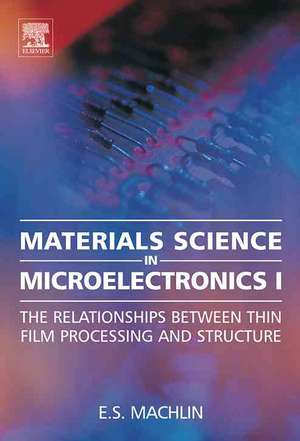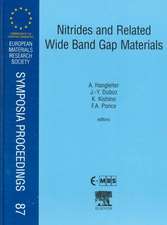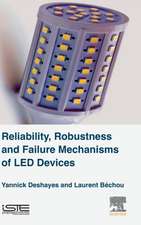Materials Science in Microelectronics I: The Relationships Between Thin Film Processing and Structure
Autor Eugene Machlinen Limba Engleză Hardback – 21 sep 2005
Preț: 899.44 lei
Preț vechi: 1232.11 lei
-27% Nou
Puncte Express: 1349
Preț estimativ în valută:
172.11€ • 184.04$ • 143.50£
172.11€ • 184.04$ • 143.50£
Carte tipărită la comandă
Preluare comenzi: 021 569.72.76
Specificații
ISBN-13: 9780080446400
ISBN-10: 008044640X
Pagini: 270
Dimensiuni: 165 x 240 x 20 mm
Greutate: 0.54 kg
Ediția:2
Editura: ELSEVIER SCIENCE
ISBN-10: 008044640X
Pagini: 270
Dimensiuni: 165 x 240 x 20 mm
Greutate: 0.54 kg
Ediția:2
Editura: ELSEVIER SCIENCE
Public țintă
Materials Science postgraduate students and researchers with an interest in thin films.Cuprins
Contents
Acknowledgment
Foreword
Preface to Revised Edition
Chapter I Deposition Parameters
1. Identification of Deposition Parameters that May Affect Thin Film Structure
2. Discussion of Vapor Deposition Parameters
2.1. Background Pressure of Chamber and Purity of Precursors
2.2. Line-of-Sight Travel of Incident Particles
2.3. Incident Particle Energy
2.4. Incident Particle Flux
2.5. Substrate and Its Cleanliness
2.6. Substrate Temperature
2.7. Composition of Deposit Relative to Target
2.8. Target
3. Deposition Parameters for Other Than PVD
4. Summary
Chapter II Defect Structure
1. Intercolumn (Interfiber) “Void Networks
1.1. Summary of Observations Concerning Intercolumn “Void Networks
1.2. Origin of Intercolumn “Void Networks
1.3. Effect of Processing On Void and Column Structure
1.4. Temperature, T1, Delineating Transition Between Presence and Absence of “Void Networks
1.5. Crystalline Versus Amorphous Structure in Zone 1
1.6. Instability of “Void Network
1.7. Deposition Methods That Eliminate The Formation of “Void Networks
2. Other Defects Introduced During Deposition At Low Substrate Temperature
2.1. Point Defects
2.2. Line Defects – Dislocations
2.3. Grain Boundaries and Stacking Faults
2.4. Three-Dimensional Defects
3. Summary of The Relations Between Deposition Methods and Defect Structures
Chapter III Grain Structure
1. Materials Science Background
2. Grain Morphology, Texture, and Size in As-Deposited Films
2.1. Vapor Deposition Onto Epitaxial Substrates in the Absence of Incident Energetic Particles.
2.2. Vapor Deposition Onto Non-Epitaxial Substrates in the Absence of Incident Energetic Particles.
2.3. Effect of Anisotropic Sticking Coefficient
2.4. Polycrystalline Semiconductors On Non-Epitaxial Substrates
2.5. Conclusions Regarding Grain Morphology, Size and Texture Produced Via Vapor Deposition in the Absence of Energetic Particles
3. Grain Morphology, Texture and Size in Vapor-Deposited Films Which Sense Energetic (Hyperthermal) Particles During Deposition
3.1. Deposition Onto Epitaxial Substrates
3.2. Deposition Onto Non-Epitaxial Substrates
3.3. Summary of Results On The Effects of Energetic Particle Bombardment During Deposition
4. Effects of Post-Deposition Processing On Grain Structure
4.1. Effect of Post-Deposition Annealing
4.2. Post-Deposition Bombardment At Elevated Temperature
Chapter IV Epitaxial Structures
1. Modes of Growth in Production of Epilayers
1.1. Modes of Growth
1.2. Modes of F–M Epilayer Growth
2. Defects Produced in Homoepitaxial Layers
2.1. Point Defects and their Clusters
2.2. Line and Planar Defects
3. Defects in Pseudomorphic Films
3.1. Coherent (Commensurate) Pseudomorphic Films
3.2. Pseudomorphically Stabilized Metastable Crystal Structures
3.3. Commensurate–Discommensurate Transition and Misfit Dislocations
4. Heteroepitaxy Between Crystals of Different Symmetry, Bonding Class or of Large Misfit
4.1. Metal/Metal Epilayer/Substrate Systems
4.2. Metal/Semiconductor Epilayer/Substrate Systems
4.3. Epitaxy At Vicinal Surfaces
4.4. Theories of Interphase Interfaces
4.5. Constraints On Epitaxy Due to Symmetry
5. Graphoepitaxy
6. Epilogue
Chapter V Structure of Amorphous Films
1. Amorphous Covalently Bonded Semiconductors
1.1. Non-Hydrogenated and Hydrogenated Group IV Elements
1.2. Amorphous Semiconductor Alloys and Compounds
2. Amorphous Metals and Alloys
3. Amorphous Oxides
3.1. Amorphous Silicon Oxide
3.2. High Dielectric Constant Amorphous Oxides
4. Amorphous 4 Crystalline Transition
Chapter VI Stresses in Thin Films
1. Intrinsic Stress
1.1. Non-Energetic Deposition
1.2. Intrinsic Stress When Film Surface Senses Energetic Particles
1.3. Intrinsic Stress Due to Phase Transformation
1.4. Intrinsic Stress Due to Epitaxy
2. Thermal Stress
Chapter VII Reaction-Induced Structure
1. Heterogeneous Reactions Between Thin Monocrystalline Layers
1.1. Completely Miscible Layers
2. Layers of Immiscible Components But Forming Intermediate Compounds
2.1. Epitaxial Monocrystalline Product Phase
2.2. Polycrystalline Compound Products
3. Reactions Between Adatoms and Substrate
3.1. Silicon Dioxide Films
4. Amorphous to Crystalline Transitions
4.1. Silicon
4.2. Carbon
4.3. Amorphous to Crystalline Transition in Other Materials
4.4. Summary of Section 4
Chapter VIII Surface Structure
1. Surface Roughness
2. Surface Modification for Producing Ordered Arrays
2.1. Periodic Surface Reconstruction Pattern
2.2. Periodic Surface Strain Pattern
2.3. Periodic Ledge Pattern
2.4. Periodic Surface Phase Pattern
2.5. Periodic Nanodots Via Kinetic Control
3. Processing and Surface Reconstruction
Index






